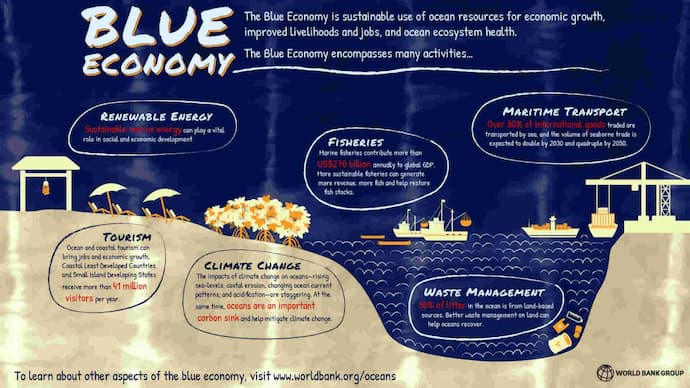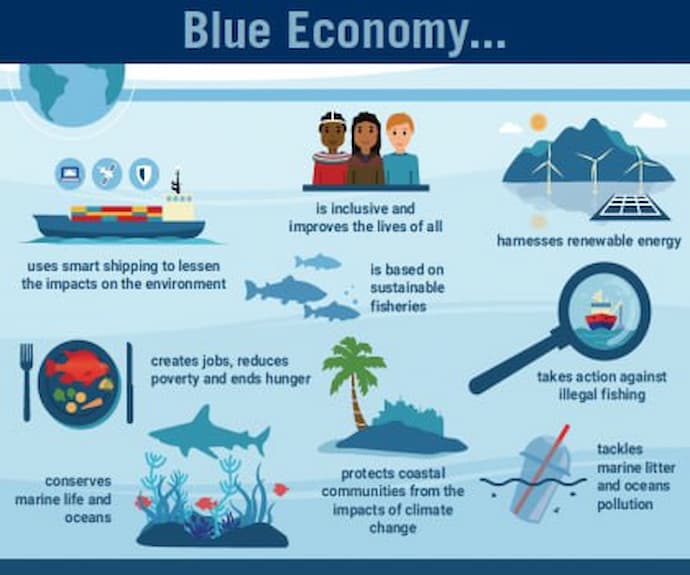World Bank Provides Road Map Report for Cambodia Blue Economy
The World Bank released a report providing an analysis and recommendations for Cambodia’s sustainable Blue Economy development with a focus on three areas related to marine policy, Marine Spatial Planning (MSP), and coastal livelihoods including the blue growth sector.
The report titled “Building a Blue Economy Roadmap for Cambodia” was released on July 3rd, 2023 detailing the opportunities for sustainable improvements in fisheries, tourism, and shipping and ports, as well as exploring emerging blue growth areas, such as blue carbon.
What Is The Blue Economy?

According to the World Bank, the blue economy is the sustainable use of ocean resources for economic growth, improved livelihoods, and jobs while preserving the health of the ocean ecosystem. The blue economy encompasses many activities such as renewable energy, fisheries, maritime transport, tourism, climate change, and waste management.
In recent years, Cambodia has released several key documents related to sustainability, including the Cambodia Green Growth RoadMap in 2009, the National Strategic Plan for Green Growth (2013-2030), and the National State of Oceans and Coasts in 2018.
What Are The Issues Concerning Cambodia's Blue Economy?
The report said the development of Cambodia's coastal and marine environments has come at a steep price, as evidenced by the stark decline in marine biodiversity, habitat loss, and the associated depletion of natural capital - all of which are symptomatic of a lack of integrated planning and management. The threats to fisheries are manifold, from conflicts between small-scale and commercial fishing to overfishing, illegal, unreported, and unregulated (IUU) fishing, habitat conversion and pollution. Cambodia's European Union (EU) Red Card status, which places the country on the list of "non-cooperating" countries from which capture fishery exports to the EU market are prohibited, underscores the severity of the situation.

World Bank Highlights Challenges For Cambodia's Blue Economy
According to the World Bank, Cambodian tourism has become a double-edged sword for its coastal regions. While it brings economic benefits, it also puts immense pressure on the environment. The surge in tourism has caused habitat degradation, pollution, and waste, leading to irresponsible tourism practices. Furthermore, the construction and dredging activities as well as the operation of ports and shipping, have raised concerns about oil spills and pollution in the sea. Adding that global climate change exacerbates these pressures, contributing to the vulnerabilities of Cambodia's coastal communities.
Meanwhile, the waste management system in Cambodia's coastal provinces are inadequate to meet the demands of the growing population and economy. The logistics, infrastructure, capacity, and resource limitations are major challenges. As a result, unsafe waste disposal methods such as burning, burying, and direct draining into the sea are commonly practised. With the post-pandemic return of tourists, the poor waste management system would further deteriorate the coastal environment. It is imperative that Cambodia addresses these challenges urgently to ensure sustainable tourism and protect the livelihoods of coastal communities.
What Are the Key Recommendations of the Blue Economy Roadmap for Cambodia?
The World Bank suggested that Cambodia should balance multiple social, economic development that aligned with environmental objectives with coordinated planning efforts and integration across all contributing sectors.
The report highlights five broad cross-cutting development objectives for progressing a sustainable Blue Economy in Cambodia that are relevant to all sectors:
- The institutional (legal and policy) framework - It suggests promoting strong decision-making with accountability through a transparent, inclusive and equitable governance.
- Integrated planning and zonation - Access to high-quality education, trainee pathways, job opportunities and local investment opportunities in an integrated planning framework promotes social equality alongside sustainability targets through cross-sector collaboration.
- MPAs and other area-based conservation areas - Increasing the coverage and effectiveness of areas that aim to sustainably use marine and coastal resources and protect high value marine and coastal assets and ecosystem services, including blue carbon. For example, community based fisheries and eco-tourism can support sustainable use.
- Capacity building - Investing in research, technology, and innovation, establishing partnerships between the government, private sector, and civil society across the region and internationally, to build capacity, skills and knowledge of managing coastal and marine spaces for sustainable use.
- Sustainable financing - Driving investment into Blue Economy opportunities through sustainable investment vehicles will promote economic efficiency, incentivise sustainable initiatives, diversify livelihoods, reduce vulnerability, and improve resilience to economic and environmental shocks.